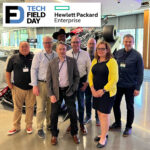|
|
This video is part of the appearance, “HPE ProLiant Liquid Cooling“. It was recorded as part of Next Gen HPE ProLiant Compute Deep Dive at 13:30-14:15 on April 8, 2025.
Watch on YouTube
Watch on Vimeo
The HPE ProLiant liquid cooling team presents a “show and tell” session focused on cooling innovation, direct liquid cooling (DLC) and closed-loop liquid cooling (CLLC). Presented by Pranay Mahendra, Mechanical and Thermal Engineer, and Keith Sauer, Mechanical Engineering Manager.
During the presentation, Keith Sauer first explains the integral work of the Houston-based engineering team responsible for designing the mechanical, thermal, tooling, and packaging elements of HPE ProLiant servers. He emphasizes how air cooling used to be treated as an afterthought, with teams historically relying on incremental improvements to manage higher thermal outputs. However, with rising power densities in hardware, traditional air cooling solutions have reached their limits. Pranay Mahendra picks up from this point to delve into the transition towards liquid cooling, highlighting HPE’s development of innovative closed-loop liquid cooling solutions that fit compact server formats like 1U, as well as direct liquid cooling systems designed to integrate into existing data centers.
Mahendra details how the closed-loop system involves internal radiators, pumps, and cold plates enclosed within the server, providing enhanced heat dissipation without needing external liquid infrastructure. These are capable of cooling up to 400–450 watts compared to traditional air-cooled configurations. The direct liquid cooling (DLC) solution, on the other hand, ties into facility-level liquid systems and offers even higher performance with significant processor temperature reduction, enabling sustained turbo modes and higher efficiency. He addresses practical concerns like leakage, which is mitigated through detection mechanisms and safety shutdowns, and stresses the cooling technology’s lifecycle and serviceability.
The session concludes with a broader discussion on the economics and deployment considerations of liquid cooling. The speakers underscore that while DLC offers compelling advantages for dense racks and high-power workloads, many data centers still operate below 29 kilowatts per rack and may prefer expanding air-cooling solutions. They compare different approaches—1U vs. 2U servers, air vs. liquid cooling—by examining cooling power, density, and total cost of ownership. Ultimately, HPE recommends careful evaluation of power, performance, and sustainability needs when considering a move to liquid cooling, emphasizing that air cooling remains viable depending on hardware configurations and customer infrastructure maturity.
Personnel: Keith Sauer, Pranay Mahendra









